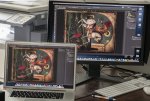Theodoros Fotometria
New member
Here is the process with which I was able to calibrate my 17" macbook pro (late 2009 - antiglare screen) with respect to my perfectly calibrated Eizo CG241W monitor with more than 97% accuracy:
1. I used "x-rite's i-one" calibrator and x-rite's i1Pro software version 2.3.3.18… still the process is a "manual" one, (warning: do not disconnect x-rite from the laptop when you enter the "manual" part of the process as it is described)
2. On "display settings" choose XY illuminator, 120cd/m2 luminance and 180:1 contrast ratio
3. Choose a point for WB reference MANUALLY as near as possible to the "white line" where the magenta/red/greed sections meet and save it in the "profile settings"…
4. Complete the automatic calibrating in the "measurement" section and save it, also save the final ICC profile…
5. Load a complicated image with lots of colour information on your reference monitor and the same image on your Macbook and open both in PS on both computers...
6. Adjust "colour balance" on the PS of your laptop until it matches as good as possible the image on your other screen… This will direct you on where to seek a new WB balance point (it should be towards the Green area of the graph), do not save the colour balance changes on your Macbook's PS… instead,
7. Return to I1Pro software and enter new values to the x&y settings according to your sense on where the correction will match the colour balance that you previously tried on PS and overwrite the new settings over the old ones in the "profile settings" DO NOT ALTER (do not recalibrate) the screen by repeating the "measurement" section… instead load the saved values on it and overwrite the new profile on the ICC…
8. Repeat the process by comparing the PS images on both screens only by altering x&y settings using careful (and small magnitude) moves until you find an XY point where you are sure that even one unit move in either direction X or Y makes things worst (it took me six and a half hours) but the result is that the screen on my macbook is now 97% as accurate as my Eizo…
I can now confidently do image processing on the laptop's screen when I have to work with painting reproduction away from studio and then come back to the Eizo and be confident of what I will print… Most important, I now know exactly the tiny readjustments that will be needed for the result to be as good as it would be if the original painting was in the studio and processing would be done on the Eizo by checking the original all the time …
I hope this will be of benefit for many. Thanks for reading.
1. I used "x-rite's i-one" calibrator and x-rite's i1Pro software version 2.3.3.18… still the process is a "manual" one, (warning: do not disconnect x-rite from the laptop when you enter the "manual" part of the process as it is described)
2. On "display settings" choose XY illuminator, 120cd/m2 luminance and 180:1 contrast ratio
3. Choose a point for WB reference MANUALLY as near as possible to the "white line" where the magenta/red/greed sections meet and save it in the "profile settings"…
4. Complete the automatic calibrating in the "measurement" section and save it, also save the final ICC profile…
5. Load a complicated image with lots of colour information on your reference monitor and the same image on your Macbook and open both in PS on both computers...
6. Adjust "colour balance" on the PS of your laptop until it matches as good as possible the image on your other screen… This will direct you on where to seek a new WB balance point (it should be towards the Green area of the graph), do not save the colour balance changes on your Macbook's PS… instead,
7. Return to I1Pro software and enter new values to the x&y settings according to your sense on where the correction will match the colour balance that you previously tried on PS and overwrite the new settings over the old ones in the "profile settings" DO NOT ALTER (do not recalibrate) the screen by repeating the "measurement" section… instead load the saved values on it and overwrite the new profile on the ICC…
8. Repeat the process by comparing the PS images on both screens only by altering x&y settings using careful (and small magnitude) moves until you find an XY point where you are sure that even one unit move in either direction X or Y makes things worst (it took me six and a half hours) but the result is that the screen on my macbook is now 97% as accurate as my Eizo…
I can now confidently do image processing on the laptop's screen when I have to work with painting reproduction away from studio and then come back to the Eizo and be confident of what I will print… Most important, I now know exactly the tiny readjustments that will be needed for the result to be as good as it would be if the original painting was in the studio and processing would be done on the Eizo by checking the original all the time …
I hope this will be of benefit for many. Thanks for reading.




